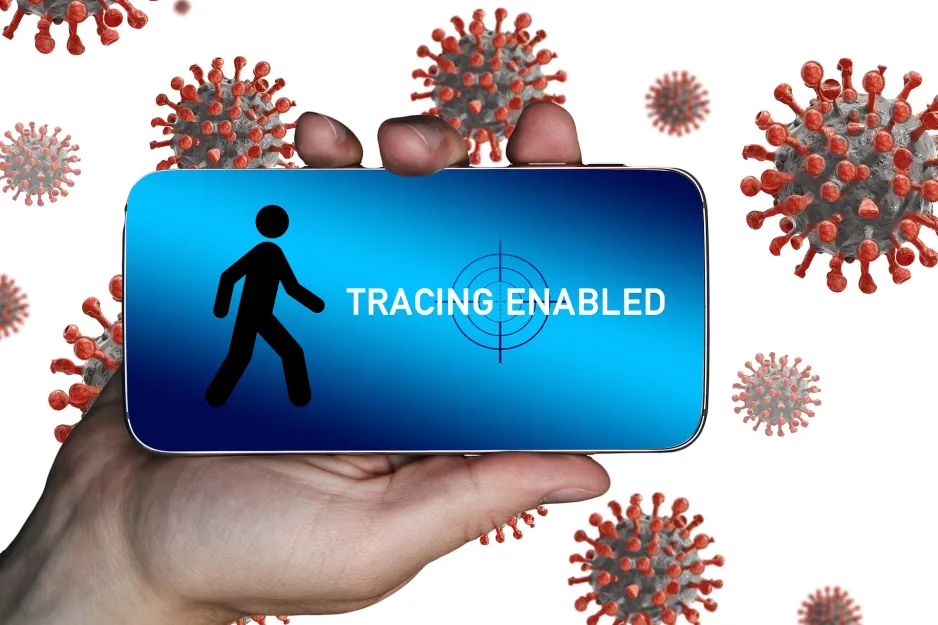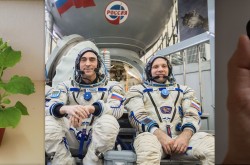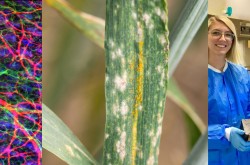5 things you should know about COVID-19, mosquitos, and bees


Meet Renée-Claude Goulet, Jesse Rogerson, and Michelle Campbell Mekarski.
They are Ingenium’s science advisors, providing expert scientific advice on key subjects relating to our three museums — the Canada Agriculture and Food Museum, the Canada Aviation and Space Museum, and the Canada Science and Technology Museum.
In this colourful monthly blog series, Ingenium’s science advisors offer up three quirky nuggets related to their areas of expertise. For the June edition, they invited their student interns to add their voices to the column. Collectively, they tackled how to avoid becoming a mosquito magnet, how to plant a buzz-worthy garden, and three things you should know about COVID-19.

How to avoid becoming a mosquito magnet
Summer has arrived, and with it comes sunshine, sweet treats…and a scourge of mosquitoes. Perhaps you’re one of the lucky ones, who never seem to get bitten. Other people seem to be mosquito magnets, spending their evenings frantically swatting at them to no avail. If you’re in the latter category, you might be wondering, “Why do they always bite me?”
Scientists had the same question. Since the 1950s, entomologists have tried to discover what attracts female mosquitoes — the only ones that bite — to their hosts. Female mosquitoes use protein-rich blood for egg development. But how exactly do they choose their victims? A combination of heat, carbon dioxide, and odours exuded from the skin makes certain people more susceptible to bites than others. Some factors, like metabolism and blood type (type O appears to be particularly delectable to mosquitoes), can’t be controlled, but here are some that can be:
- Exercise: As it turns out, mosquitoes are big fans of your summer workout plan. The body produces more heat, carbon dioxide, and sweat through exercise and heavy breathing. Mosquitoes are attracted to compounds found in sweat, like lactic acid and ammonia.
- What not to wear: Mosquitoes have a preference for resting on dark surfaces, which means you might want to opt against dark clothing in the summer months. Mosquitoes orient toward dark visual cues, especially when combined with a warm body temperature and carbon dioxide.
- Alcohol consumption: Heading out to enjoy a beer out on the patio? You may want to bring along mosquito repellent, too. Drinking beer can induce changes in breath and body odour that attract mosquitoes towards you. So, it isn’t your imagination. Those pesky mosquitoes might have it out for you, but there are some ways you can try to keep them at bay while you enjoy the warm, wonderful weather.
By Aarani Mathialagan

Sweat bees (genus Agapostemon) are often mistaken for flies because of their iridescent green colouring.
Plant a buzz-worthy garden
Ontario is home to more than 400 native species of bees that fertilize plants — such as blueberry bushes and peach trees — by transferring pollen from one flower to another. But the numbers of native bees are declining rapidly due to habitat loss, pesticides, disease, and changing weather. Fifteen of Canada's wild bee species are listed as threatened, and one — the rusty-patched bumble bee — was last seen in 2009 and is considered endangered. Fortunately, there’s a simple way we can use our own backyards to save our native bees.
Unlike the hive full of yellow, honey-producing bees you might be picturing, most native Canadian bees don’t produce honey and come in a variety of sizes and colours; you might even mistake the metallic green sweat bee for a fly as it flutters by! Most native bees hibernate, raise their young in nests, and forage for nectar and pollen in colourful flowers. Unfortunately, manicured grass lawns are devoid of food and plant litter for nesting. So, by simply planting diverse gardens filled with native flowers, we can replenish food and shelter sources for local bees.
Here are some simple tips:
- Search online for plants local to your area (here’s a guide for Canada)
- Plant a variety of native plants to attract many species of bees
- Keep sticks and leaf litter in your garden for bees to live and reproduce in
- Don’t worry about getting stung — the critters that enjoy your BBQ are likely wasps, not bees
After planting your bee-friendly garden, you’ll enjoy that juicy peach from your local farmers’ market that much more — knowing that you played a small part in putting it on your plate.
By Victoria Banderob

COVID-19 and farm animals
Imagine you are visiting a farm. You are greeted by a host who hands you disposable plastic boot coverings to wear, then asks you to step through a foot bath containing a disinfecting solution. Inside the barn, you may only see the animals through a window, and when you exit, you step through a foot bath again.
These are not new restrictions due to COVID-19, but typical biosecurity measures farmers put in place to protect their animals and crops from infectious disease. Whether sick or not, we may be carrying disease-causing agents (pathogens) from our environment, which can have devastating impacts on animals and crops.
Biosecurity reduces the risks of spreading disease between farms, between animals within a herd, between humans and animals, and also between wild and domesticated populations of animals, like birds. Biosecurity is vital during human viral pandemics. If humans were to pass the virus to animal populations, these could become future sources of infection for us. Infecting a new host also provides an opportunity for a virus to mutate — which can increase its infectiousness, worsen its symptoms, or allow it to move on to another species.
Not all viruses can jump from humans to livestock or vice-versa. However, some species are more at risk of sharing diseases with us, such as pigs and chickens — who can be infected by, and transmit different forms of influenza.
Researchers around the world are now studying whether COVID-19 can infect different animal species, and if so, whether that is a risk to us. Findings so far suggest that pigs and poultry may not be susceptible to the virus. Whether cattle and other livestock can be infected is still unknown, but there is active research in this area. Until we know more, we should avoid all unnecessary contact with farm animals.
By Renée-Claude Goulet

Experts determine contact tracing would be more efficient using smart phone apps
Contact tracing COVID-19 using smartphone apps
Would you use an app that tracked your contact with other app users so that if one of you is diagnosed with COVID-19, everyone could be quickly alerted?
Scientists at Oxford University recently published a paper in the journal Science suggesting that this may be the most efficient way to slow the pandemic, when combined with other more established methods (e.g., physical distancing, hand washing).
When someone tests positive for COVID-19, it’s important to ask who they have been in contact with. Tracing back their contact with other people — and alerting those people to potential infection — can greatly help in slowing further transmission. Unfortunately, conventional contact tracing may not be quick enough. The current reproductive rate of COVID-19 is too large for manual contact tracing to slow the spread. The authors of the study suggest that a digital form of contact tracing using smartphones would allow instantaneous tracing of human contacts.
Imagine an app: you download and activate it, allowing it to run in the background. Each time you get closer than two metres to someone else who is also running the app, it logs the interaction. If you or anyone else you’ve interacted with tests positive for COVID-19, the app could work back through the interaction logs and notify everyone.
The authors of the article note that enough people would have to adopt the app for it to be viable, and there are a number of ethical concerns related to transparency, data, and oversight. While we all ponder the implications of such an app, we must all remember to keep a physical distance of two metres, stay home as much as possible, and to wash our hands as frequently as we can.
By Jesse Rogerson

Physical distancing numbers: Why two metres?
After months of public health announcements, we are all familiar with the physical distancing measure that advises us to stay two metres (about 6.5 feet) away from anyone we don’t live with. But where did that number come from? To understand, we need to know how viruses spread.
Viruses — coronaviruses included — can spread between people in several ways. When an infected person breathes, coughs, sneezes, or speaks, they project droplets that contain virus particles. Some of these droplets are fairly large (e.g., from a sneeze or cough) and sometimes, viruses can be spread in very small droplets called aerosols.
Larger droplets have the potential to carry more virus particles, but because they’re heavier, they fall quickly and travel shorter distances. In fact, most large droplets fall to the ground (or the nearest surface) within two metres (hence, the two-metre physical distancing recommendation). Covering coughs and sneezes and wearing cloth masks can help further reduce the distance that large droplets travel. Aerosols are so tiny that they can float in the air and travel much further (though being smaller, they carry fewer virus particles and pose a smaller risk).
Does that mean that you are safe from coronavirus-laden droplets beyond two metres? Unfortunately no; some large droplets travel further than two metres, and new research indicates that SARS-CoV-2 can travel as an aerosol in the air. So the bottom line is: the two-metre guideline keeps you away from the vast majority of virus particles spread by nearby people, but the greater your distance, the safer you are.
By Michelle Campbell Mekarski
















